BK Channels in Tail Artery Vascular Smooth Muscle Cells of Normotensive (WKY) and Hypertensive (SHR) Rats Possess Similar Calcium Sensitivity But Different Responses to the Vasodilator Iloprost
Abstract
:1. Introduction
2. Results
2.1. Comparison of the Properties of BK Channels in Tail Artery VSMCs of WKY and SHR
2.2. Comparison of the Properties of BK Currents in Tail Artery VSMCs of WKY and SHR
2.3. Comparison of the Effect of Iloprost on BK Currents in Tail Artery VSMCs of WKY and SHR
2.4. Comparison of the Effect of Activation of Components of the PKA Pathway on BK Currents in Tail Artery VSMCs of WKY and SHR
3. Discussion
3.1. Properties of BK Channels and BK Currents in Tail Artery VSMCs of WKY and SHR
3.2. Effect of Activation of Components of the PKA Pathway on BK Currents in Tail Artery VSMCs of WKY and SHR
4. Materials and Methods
4.1. Dissection of the Vessels
4.2. Cell Isolation
4.3. Patch-Clamp Recording
4.4. Drugs and Chemicals
4.5. Statistics
Author Contributions
Funding
Institutional Review Board Statement
Informed Consent Statement
Data Availability Statement
Conflicts of Interest
References
- Tykocki, N.R.; Boerman, E.M.; Jackson, W.F. Smooth Muscle Ion Channels and Regulation of Vascular Tone in Resistance Arteries and Arterioles. Compr. Physiol. 2017, 7, 485–581. [Google Scholar] [PubMed]
- Cohen, M.L.; Berkowitz, B.A. Decreased vascular relaxation in hypertension. J. Pharmacol. Exp. Ther. 1976, 196, 396–406. [Google Scholar]
- Field, F.P.; Soltis, E.E. Vascular reactivity in the spontaneously hypertensive rat. Effect of high pressure stress and extracellular calcium. Hypertension 1985, 7, 228–235. [Google Scholar] [CrossRef] [PubMed]
- Fujimoto, S.; Dohi, Y.; Aoki, K.; Matsuda, T. Beta1- and beta2-adrenoceptor-mediated relaxation responses in peripheral arteries from spontaneously hypertensive rats at pre-hypertensive and early hypertensive stages. J. Hypertens 1988, 6, 543–550. [Google Scholar] [CrossRef] [PubMed]
- Asano, M.; Masuzawa, K.; Matsuda, T. Evidence for reduced β-adrenoceptor coupling to adenylate cyclase in femoral arteries from spontaneously hypertensive rats. Br. J. Pharmacol. 1988, 94, 73–86. [Google Scholar] [CrossRef] [PubMed]
- Asano, M.; Masuzawa, K.; Matsuda, T. Role of stimulatory GTP-binding protein (Gs) in reduced β-adrenoceptor coupling in the femoral artery of spontaneously hypertensive rats. Br. J. Pharmacol. 1988, 95, 241–251. [Google Scholar] [CrossRef] [PubMed]
- Masuzawa, K.; Matsuda, T.; Asano, M. Decreased arterial responsiveness to multiple cyclic AMP-generating receptor agonists in spontaneously hypertensive rats. Br. J. Pharmacol. 1989, 96, 227–235. [Google Scholar] [CrossRef] [PubMed]
- Asano, M.; Masuzawa, K.; Matsuda, T.; Asano, T. Decreased responsiveness to β-adrenoceptor agonists in arterial strips from spontaneously hypertensive rats is not associated with alterations in β-adrenoceptors. J. Hypertens 1991, 9, 607–613. [Google Scholar] [CrossRef] [PubMed]
- Blankesteijn, W.M.; Raat, N.J.; Willems, P.H.; Thien, T. β-Adrenergic relaxation in mesenteric resistance arteries of spontaneously hypertensive and Wistar-Kyoto rats: The role of precontraction and intracellular Ca2+. J. Cardiovasc. Pharmacol. 1996, 27, 27–32. [Google Scholar] [CrossRef] [PubMed]
- Goto, K.; Fujii, K.; Abe, I. Impaired β-adrenergic hyperpolarization in arteries from prehypertensive spontaneously hypertensive rats. Hypertension 2001, 37, 609–613. [Google Scholar] [CrossRef]
- Chadha, P.S.; Zunke, F.; Zhu, H.L.; Davis, A.J.; Jepps, T.A.; Olesen, S.P.; Cole, W.C.; Moffatt, J.D.; Greenwood, I.A. Reduced KCNQ4-encoded voltage-dependent potassium channel activity underlies impaired β-adrenoceptor-mediated relaxation of renal arteries in hypertension. Hypertension 2012, 59, 877–884. [Google Scholar] [CrossRef] [PubMed]
- Valovic, P.; Behuliak, M.; Vaneckova, I.; Zicha, J. Impaired vascular β-adrenergic relaxation in spontaneously hypertensive rats: The differences between conduit and resistance arteries. Eur. J. Pharmacol. 2023, 958, 176045. [Google Scholar] [CrossRef] [PubMed]
- van der Horst, J.; Rognant, S.; Hellsten, Y.; Aalkjaer, C.; Jepps, T.A. Dynein Coordinates β2-Adrenoceptor-Mediated Relaxation in Normotensive and Hypertensive Rat Mesenteric Arteries. Hypertension 2022, 79, 2214–2227. [Google Scholar] [CrossRef] [PubMed]
- Clark, C.J.; Milligan, G.; McLellan, A.R.; Connell, J.M. Guanine nucleotide regulatory proteins in the spontaneously hypertensive rat. Hypertension 1993, 21, 204–209. [Google Scholar] [CrossRef] [PubMed]
- Stekiel, W.J.; Contney, S.J.; Rusch, N.J. Altered β-receptor control of in situ membrane potential in hypertensive rats. Hypertension 1993, 21 Pt 2, 1005–1009. [Google Scholar] [CrossRef] [PubMed]
- Schubert, R.; Nelson, M.T. Protein kinases: Tuners of the BKCa channel in smooth muscle. Trends Pharmacol. Sci. 2001, 22, 505–512. [Google Scholar] [CrossRef] [PubMed]
- Rusch, N.J.; De Lucena, R.G.; Wooldridge, T.A.; England, S.K.; Cowley, A.W., Jr. A Ca2+-dependent K+ current is enhanced in arterial membranes of hypertensive rats. Hypertension 1992, 19, 301–307. [Google Scholar] [CrossRef] [PubMed]
- Kolias, T.J.; Chai, S.; Webb, R.C. Potassium channel antagonists and vascular reactivity in stroke-prone spontaneously hypertensive rats. Am. J. Hypertens 1993, 6 Pt 1, 528–533. [Google Scholar] [CrossRef] [PubMed]
- Paterno, R.; Heistad, D.D.; Faraci, F.M. Functional activity of Ca2+-dependent K+ channels is increased in basilar artery during chronic hypertension. Am. J. Physiol. 1997, 272, H1287–H1291. [Google Scholar] [CrossRef]
- Liu, Y.; Hudetz, A.G.; Knaus, H.G.; Rusch, N.J. Increased expression of Ca2+-sensitive K+ channels in the cerebral microcirculation of genetically hypertensive rats: Evidence for their protection against cerebral vasospasm. Circ. Res. 1998, 82, 729–737. [Google Scholar] [CrossRef] [PubMed]
- Rusch, N.J.; Runnells, A.M. Remission of high blood pressure reverses arterial potassium channel alterations. Hypertension 1994, 23 Pt 2, 941–945. [Google Scholar] [CrossRef] [PubMed]
- Asano, M.; Masuzawa-Ito, K.; Matsuda, T. Charybdotoxin-sensitive K+ channels regulate the myogenic tone in the resting state of arteries from spontaneously hypertensive rats. Br. J. Pharmacol. 1993, 108, 214–222. [Google Scholar] [CrossRef] [PubMed]
- Cox, R.H.; Lozinskaya, I.; Dietz, N.J. Differences in K+ current components in mesenteric artery myocytes from WKY and SHR. Am. J. Hypertens 2001, 14, 897–907. [Google Scholar] [CrossRef] [PubMed]
- Kamouchi, M.; Kitazono, T.; Nagao, T.; Fujishima, M.; Ibayashi, S. Role of Ca2+-activated K+ channels in the regulation of basilar arterial tone in spontaneously hypertensive rats. Clin. Exp. Pharmacol. Physiol. 2002, 29, 575–581. [Google Scholar] [CrossRef] [PubMed]
- Li, Z.; Lu, N.; Shi, L. Exercise training reverses alterations in Kv and BKCa channel molecular expression in thoracic aorta smooth muscle cells from spontaneously hypertensive rats. J. Vasc. Res. 2014, 51, 447–457. [Google Scholar] [CrossRef] [PubMed]
- Shi, L.; Zhang, H.; Chen, Y.; Liu, Y.; Lu, N.; Zhao, T.; Zhang, L. Chronic exercise normalizes changes in Cav 1.2 and KCa 1.1 channels in mesenteric arteries from spontaneously hypertensive rats. Br. J. Pharmacol. 2015, 172, 1846–1858. [Google Scholar] [CrossRef] [PubMed]
- Shi, L.; Zhang, Y.; Liu, Y.; Gu, B.; Cao, R.; Chen, Y.; Zhao, T. Exercise Prevents Upregulation of RyRs-BKCa Coupling in Cerebral Arterial Smooth Muscle Cells From Spontaneously Hypertensive Rats. Arterioscler. Thromb. Vasc. Biol. 2016, 36, 1607–1617. [Google Scholar] [CrossRef] [PubMed]
- England, S.K.; Wooldridge, T.A.; Stekiel, W.J.; Rusch, N.J. Enhanced single-channel K+ current in arterial membranes from genetically hypertensive rats. Am. J. Physiol. 1993, 264, H1337–H1345. [Google Scholar] [CrossRef] [PubMed]
- Cox, R.H.; Lozinskaya, I.; Matsuda, K.; Dietz, N.J. Ramipril treatment alters Ca2+ and K+ channels in small mesenteric arteries from Wistar-Kyoto and spontaneously hypertensive rats. Am. J. Hypertens 2002, 15, 879–890. [Google Scholar] [PubMed]
- Amberg, G.C.; Bonev, A.D.; Rossow, C.F.; Nelson, M.T.; Santana, L.F. Modulation of the molecular composition of large conductance, Ca2+ activated K(+) channels in vascular smooth muscle during hypertension. J. Clin. Investig. 2003, 112, 717–724. [Google Scholar] [CrossRef]
- Liu, Y.; Pleyte, K.; Knaus, H.G.; Rusch, N.J. Increased expression of Ca2+-sensitive K+ channels in aorta of hypertensive rats. Hypertension 1997, 30, 1403–1409. [Google Scholar] [CrossRef] [PubMed]
- Cox, R.H.; Lozinskaya, I.; Dietz, N.J. Calcium exerts a larger regulatory effect on potassium channels in small mesenteric artery mycoytes from spontaneously hypertensive rats compared to Wistar-Kyoto rats. Am. J. Hypertens 2003, 16, 21–27. [Google Scholar] [CrossRef] [PubMed]
- Zhang, Y.; Gao, Y.J.; Zuo, J.; Lee, R.M.; Janssen, L.J. Alteration of arterial smooth muscle potassium channel composition and BKCa current modulation in hypertension. Eur. J. Pharmacol. 2005, 514, 111–119. [Google Scholar] [CrossRef] [PubMed]
- Kiyoshi, H.; Yamazaki, D.; Ohya, S.; Kitsukawa, M.; Muraki, K.; Saito, S.Y.; Ohizumi, Y.; Imaizumi, Y. Molecular and electrophysiological characteristics of K+ conductance sensitive to acidic pH in aortic smooth muscle cells of WKY and SHR. Am. J. Physiol. Heart Circ. Physiol. 2006, 291, H2723–H2734. [Google Scholar] [CrossRef] [PubMed]
- Cox, R.H. Comparison of K+ channel properties in freshly isolated myocytes from thoracic aorta of WKY and SHR. Am. J. Hypertens 1996, 9, 884–894. [Google Scholar] [CrossRef] [PubMed]
- Niloy, S.I.; Shen, Y.; Guo, L.; O’Rourke, S.T.; Sun, C. Loss of IP3R-BKCa Coupling Is Involved in Vascular Remodeling in Spontaneously Hypertensive Rats. Int. J. Mol. Sci. 2023, 24, 10903. [Google Scholar] [CrossRef]
- Leo, M.D.; Zhai, X.; Yin, W.; Jaggar, J.H. Impaired Trafficking of β1 Subunits Inhibits BK Channels in Cerebral Arteries of Hypertensive Rats. Hypertension 2018, 72, 765–775. [Google Scholar] [CrossRef] [PubMed]
- Keef, K.D.; Hume, J.R.; Zhong, J. Regulation of cardiac and smooth muscle Ca2+ channels (CaV1.2a,b) by protein kinases. Am. J. Physiol. Cell Physiol. 2001, 281, C1743–C1756. [Google Scholar] [CrossRef]
- Navedo, M.F.; Takeda, Y.; Nieves-Cintron, M.; Molkentin, J.D.; Santana, L.F. Elevated Ca2+ sparklet activity during acute hyperglycemia and diabetes in cerebral arterial smooth muscle cells. Am. J. Physiol. Cell Physiol. 2010, 298, C211–C220. [Google Scholar] [CrossRef] [PubMed]
- Porter, V.A.; Bonev, A.D.; Knot, H.J.; Heppner, T.J.; Stevenson, A.S.; Kleppisch, T.; Lederer, W.J.; Nelson, M.T. Frequency modulation of Ca2+ sparks is involved in regulation of arterial diameter by cyclic nucleotides. Am. J. Physiol. 1998, 274, C1346–C1355. [Google Scholar] [CrossRef]
- Wellman, G.C.; Santana, L.F.; Bonev, A.D.; Nelson, M.T. Role of phospholamban in the modulation of arterial Ca2+ sparks and Ca2+-activated K+ channels by cAMP. Am. J. Physiol. Cell Physiol. 2001, 281, C1029–C1037. [Google Scholar] [CrossRef] [PubMed]
- Rusch, N.J.; Hermsmeyer, K. Calcium currents are altered in the vascular muscle cell membrane of spontaneously hypertensive rats. Circ. Res. 1988, 63, 997–1002. [Google Scholar] [CrossRef] [PubMed]
- Cox, R.H.; Lozinskaya, I.M. Augmented calcium currents in mesenteric artery branches of the spontaneously hypertensive rat. Hypertension 1995, 26, 1060–1064. [Google Scholar] [CrossRef] [PubMed]
- Wilde, D.W.; Furspan, P.B.; Szocik, J.F. Calcium current in smooth muscle cells from normotensive and genetically hypertensive rats. Hypertension 1994, 24, 739–746. [Google Scholar] [CrossRef] [PubMed]
- Nieves-Cintron, M.; Amberg, G.C.; Navedo, M.F.; Molkentin, J.D.; Santana, L.F. The control of Ca2+ influx and NFATc3 signaling in arterial smooth muscle during hypertension. Proc. Natl. Acad. Sci. USA 2008, 105, 15623–15628. [Google Scholar] [CrossRef] [PubMed]
- Amberg, G.C.; Santana, L.F. Downregulation of the BK channel β1 subunit in genetic hypertension. Circ. Res. 2003, 93, 965–971. [Google Scholar] [CrossRef] [PubMed]
- Schubert, R.; Serebryakov, V.N.; Engel, H.; Hopp, H.H. Iloprost activates KCa channels of vascular smooth muscle cells: Role of cAMP-dependent protein kinase. Am. J. Physiol. 1996, 271, C1203–C1211. [Google Scholar] [CrossRef] [PubMed]
- Schubert, R.; Noack, T.; Serebryakov, V.N. Protein kinase C reduces the KCa current of rat tail artery smooth muscle cells. Am. J. Physiol. 1999, 276, C648–C658. [Google Scholar] [CrossRef] [PubMed]
- Sandberg, M.; Butt, E.; Nolte, C.; Fischer, L.; Halbrugge, M.; Beltman, J.; Jahnsen, T.; Genieser, H.G.; Jastorff, B.; Walter, U. Characterization of Sp-5,6-dichloro-1-β-D-ribofuranosylbenzimidazole- 3′,5′-monophosphorothioate (Sp-5,6-DCl-cBiMPS) as a potent and specific activator of cyclic-AMP-dependent protein kinase in cell extracts and intact cells. Biochem. J. 1991, 279, 521–527. [Google Scholar] [CrossRef] [PubMed]
- Bregestovski, P.D.; Printseva, O.; Serebryakov, V.; Stinnakre, J.; Turmin, A.; Zamoyski, V. Comparison of Ca2+-dependent K+ channels in the membrane of smooth muscle cells isolated from adult and foetal human aorta. Pflug. Arch. 1988, 413, 8–13. [Google Scholar] [CrossRef] [PubMed]
- Post, J.M.; Gelband, C.H.; Hume, J.R. [Ca2+]i inhibition of K+ channels in canine pulmonary artery. Novel mechanism for hypoxia-induced membrane depolarization. Circ. Res. 1995, 77, 131–139. [Google Scholar] [CrossRef] [PubMed]
- Kirber, M.T.; Ordway, R.W.; Clapp, L.H.; Walsh, J.V., Jr.; Singer, J.J. Both membrane stretch and fatty acids directly activate large conductance Ca2+-activated K+ channels in vascular smooth muscle cells. FEBS Lett. 1992, 297, 24–28. [Google Scholar] [CrossRef] [PubMed]
- Gelband, G.H.; McCullough, J.R. Modulation of rabbit aortic Ca2+-activated K+ channels by pinacidil, cromakalim, and glibenclamide. Am. J. Physiol. 1993, 264, C1119–C1127. [Google Scholar] [CrossRef] [PubMed]
- Toro, L.; Vaca, L.; Stefani, E. Calcium-activated potassium channels from coronary smooth muscle reconstituted in lipid bilayers. Am. J. Physiol. 1991, 260, H1779–H1789. [Google Scholar] [CrossRef] [PubMed]
- Jackson, W.F.; Blair, K.L. Characterization and function of Ca2+-activated K+ channels in arteriolar muscle cells. Am. J. Physiol. 1998, 274, H27–H34. [Google Scholar] [CrossRef] [PubMed]
- Sansom, S.C.; Stockand, J.D. Differential Ca2+ sensitivities of BK(Ca) isochannels in bovine mesenteric vascular smooth muscle. Am. J. Physiol. 1994, 266, C1182–C1189. [Google Scholar] [CrossRef] [PubMed]
- Wang, Y.; Mathers, D.A. Ca2+-dependent K+ channels of high conductance in smooth muscle cells isolated from rat cerebral arteries. J. Physiol. 1993, 462, 529–545. [Google Scholar] [CrossRef] [PubMed]
- Schubert, R.; Gaynullina, D.; Shvetsova, A.; Tarasova, O.S. Myography of isolated blood vessels: Considerations for experimental design and combination with supplementary techniques. Front. Physiol. 2023, 14, 1176748. [Google Scholar] [CrossRef] [PubMed]
- Poulsen, A.N.; Wulf, H.; Hay-Schmidt, A.; Jansen-Olesen, I.; Olesen, J.; Klaerke, D.A. Differential expression of BK channel isoforms and β-subunits in rat neuro-vascular tissues. Biochim. Biophys. Acta 2009, 1788, 380–389. [Google Scholar] [CrossRef] [PubMed]
- Nourian, Z.; Li, M.; Leo, M.D.; Jaggar, J.H.; Braun, A.P.; Hill, M.A. Large conductance Ca2+-activated K+ channel (BKCa) α-subunit splice variants in resistance arteries from rat cerebral and skeletal muscle vasculature. PLoS ONE 2014, 9, e98863. [Google Scholar] [CrossRef] [PubMed]
- Tanaka, Y.; Meera, P.; Song, M.; Knaus, H.G.; Toro, L. Molecular constituents of maxi KCa channels in human coronary smooth muscle: Predominant α + β subunit complexes. J. Physiol. 1997, 502, 545–557. [Google Scholar] [CrossRef] [PubMed]
- Yang, Y.; Murphy, T.V.; Ella, S.R.; Grayson, T.H.; Haddock, R.; Hwang, Y.T.; Braun, A.P.; Peichun, G.; Korthuis, R.J.; Davis, M.J.; et al. Heterogeneity in function of small artery smooth muscle BKCa: Involvement of the β1-subunit. J. Physiol. 2009, 587, 3025–3044. [Google Scholar] [CrossRef] [PubMed]
- Yang, Y.; Sohma, Y.; Nourian, Z.; Ella, S.R.; Li, M.; Stupica, A.; Korthuis, R.J.; Davis, M.J.; Braun, A.P.; Hill, M.A. Mechanisms underlying regional differences in the Ca2+ sensitivity of BKCa current in arteriolar smooth muscle. J. Physiol. 2013, 591, 1277–1293. [Google Scholar] [CrossRef] [PubMed]
- Guia, A.; Wan, X.; Courtemanche, M.; Leblanc, N. Local Ca2+ entry through L-type Ca2+ channels activates Ca2+-dependent K+ channels in rabbit coronary myocytes. Circ. Res. 1999, 84, 1032–1042. [Google Scholar] [CrossRef] [PubMed]
- Nelson, M.T.; Cheng, H.; Rubart, M.; Santana, L.F.; Bonev, A.D.; Knot, H.J.; Lederer, W.J. Relaxation of arterial smooth muscle by calcium sparks. Science 1995, 270, 633–637. [Google Scholar] [CrossRef] [PubMed]
- Bychkov, R.; Gollasch, M.; Ried, C.; Luft, F.C.; Haller, H. Regulation of spontaneous transient outward potassium currents in human coronary arteries. Circulation 1997, 95, 503–510. [Google Scholar] [CrossRef] [PubMed]
- Schubert, R.; Serebryakov, V.N.; Mewes, H.; Hopp, H.H. Iloprost dilates rat small arteries: Role of K(ATP)- and K(Ca)-channel activation by cAMP-dependent protein kinase. Am. J. Physiol. 1997, 272, H1147–H1156. [Google Scholar] [CrossRef] [PubMed]
- Kyle, B.D.; Braun, A.P. The regulation of BK channel activity by pre- and post-translational modifications. Front. Physiol. 2014, 5, 316. [Google Scholar] [CrossRef] [PubMed]
- Nara, M.; Dhulipala, P.D.; Wang, Y.X.; Kotlikoff, M.I. Reconstitution of β-adrenergic modulation of large conductance, calcium-activated potassium (maxi-K) channels in Xenopus oocytes. Identification of the camp-dependent protein kinase phosphorylation site. J. Biol. Chem. 1998, 273, 14920–14924. [Google Scholar] [CrossRef] [PubMed]
- Shipston, M.J.; Tian, L. Posttranscriptional and Posttranslational Regulation of BK Channels. Int. Rev. Neurobiol. 2016, 128, 91–126. [Google Scholar]
- Taylor, S.S.; Buechler, J.A.; Yonemoto, W. cAMP-dependent protein kinase: Framework for a diverse family of regulatory enzymes. Annu. Rev. Biochem. 1990, 59, 971–1005. [Google Scholar] [CrossRef] [PubMed]
- Yang, C.; Yang, J.; Xu, X.; Yan, S.; Pan, S.; Pan, X.; Zhang, C.; Leung, G.P. Vasodilatory effect of 14,15-epoxyeicosatrienoic acid on mesenteric arteries in hypertensive and aged rats. Prostaglandins Other Lipid Mediat. 2014, 112, 1–8. [Google Scholar] [CrossRef] [PubMed]
- Schubert, R.; Lehmann, G.; Serebryakov, V.N.; Mewes, H.; Hopp, H.H. cAMP-dependent protein kinase is in an active state in rat small arteries possessing a myogenic tone. Am. J. Physiol. 1999, 277, H1145–H1155. [Google Scholar] [CrossRef] [PubMed]
- Gagov, H.; Gribkova, I.V.; Serebryakov, V.N.; Schubert, R. Sodium Nitroprusside-Induced Activation of Vascular Smooth Muscle BK Channels Is Mediated by PKG Rather Than by a Direct Interaction with NO. Int. J. Mol. Sci. 2022, 23, 2798. [Google Scholar] [CrossRef] [PubMed]
- Schubert, R. Multiple ligand-ion solutions: A guide for solution preparation and computer program understanding. J. Vasc. Res. 1996, 33, 86–98. [Google Scholar] [CrossRef] [PubMed]
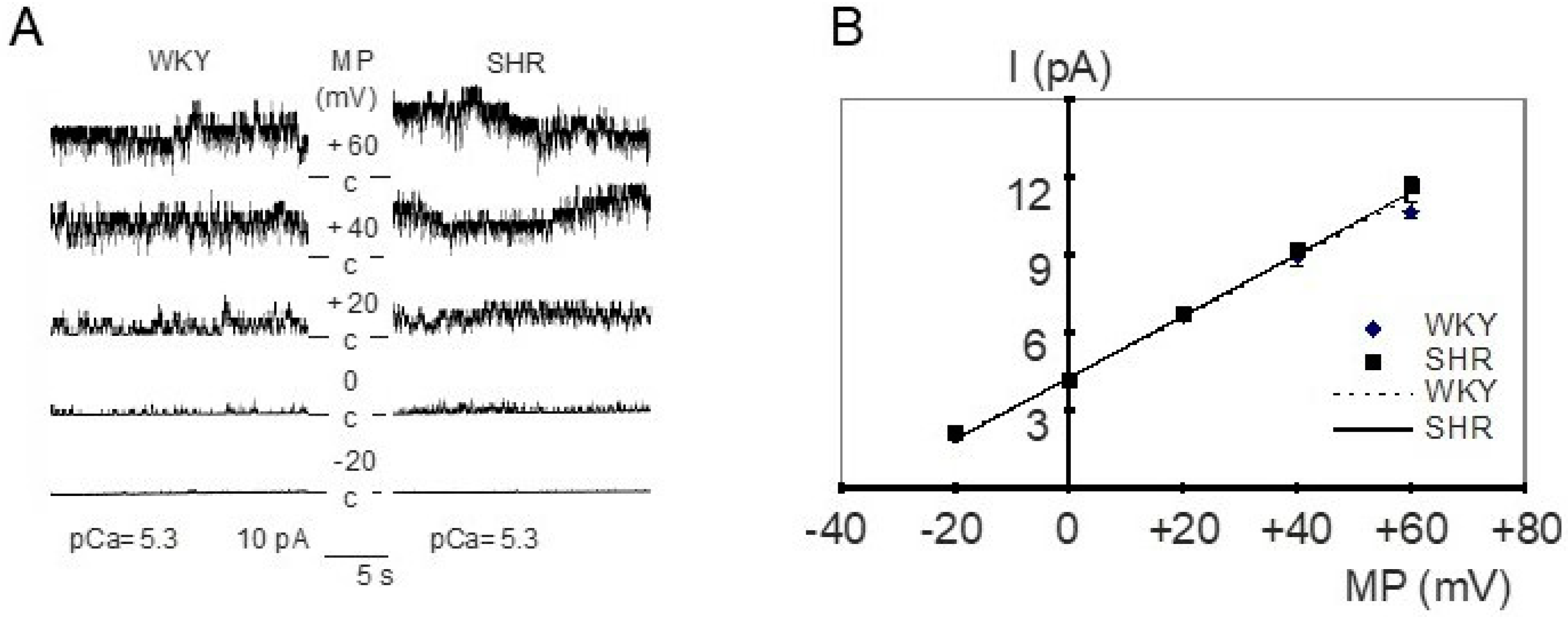
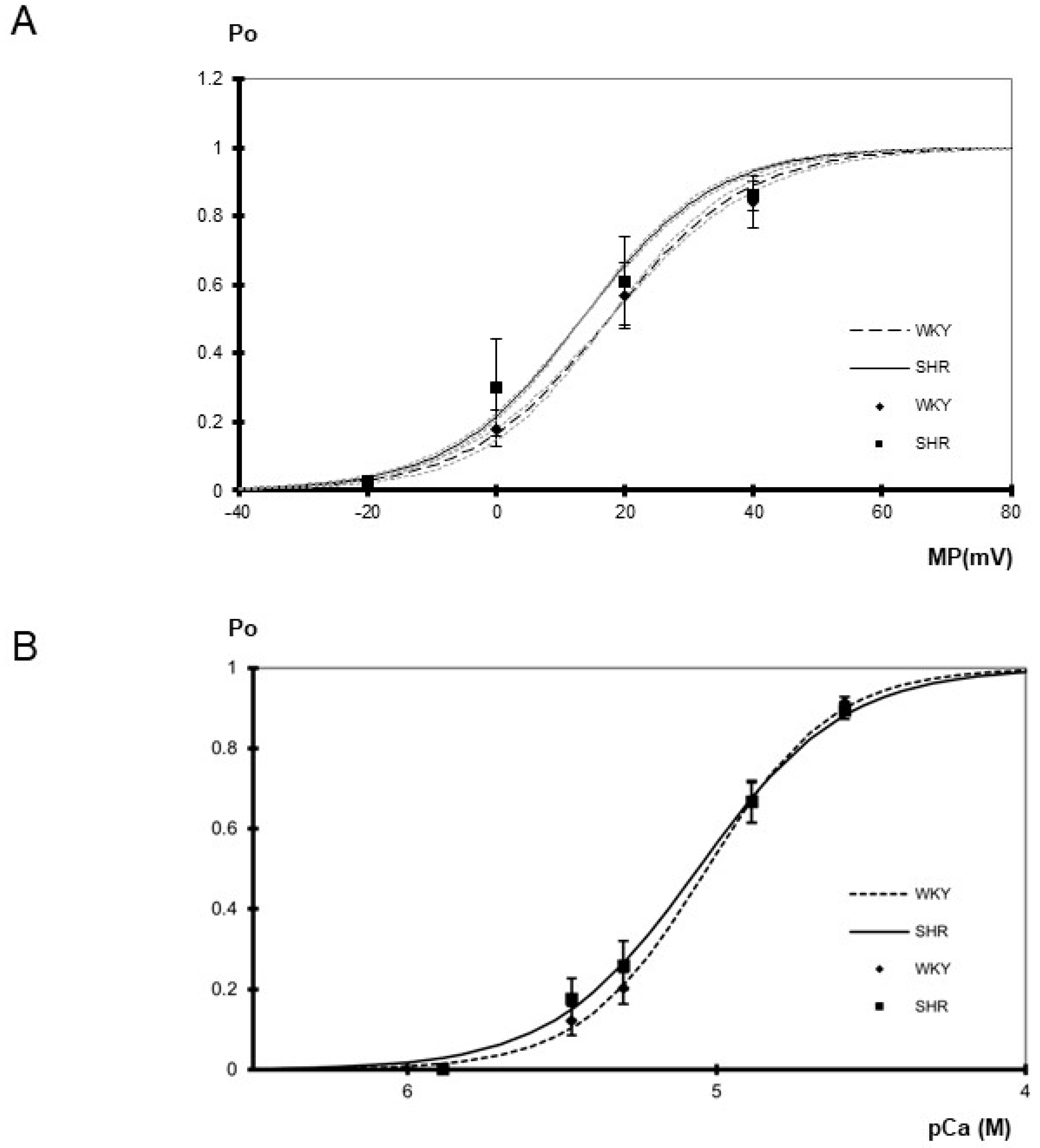
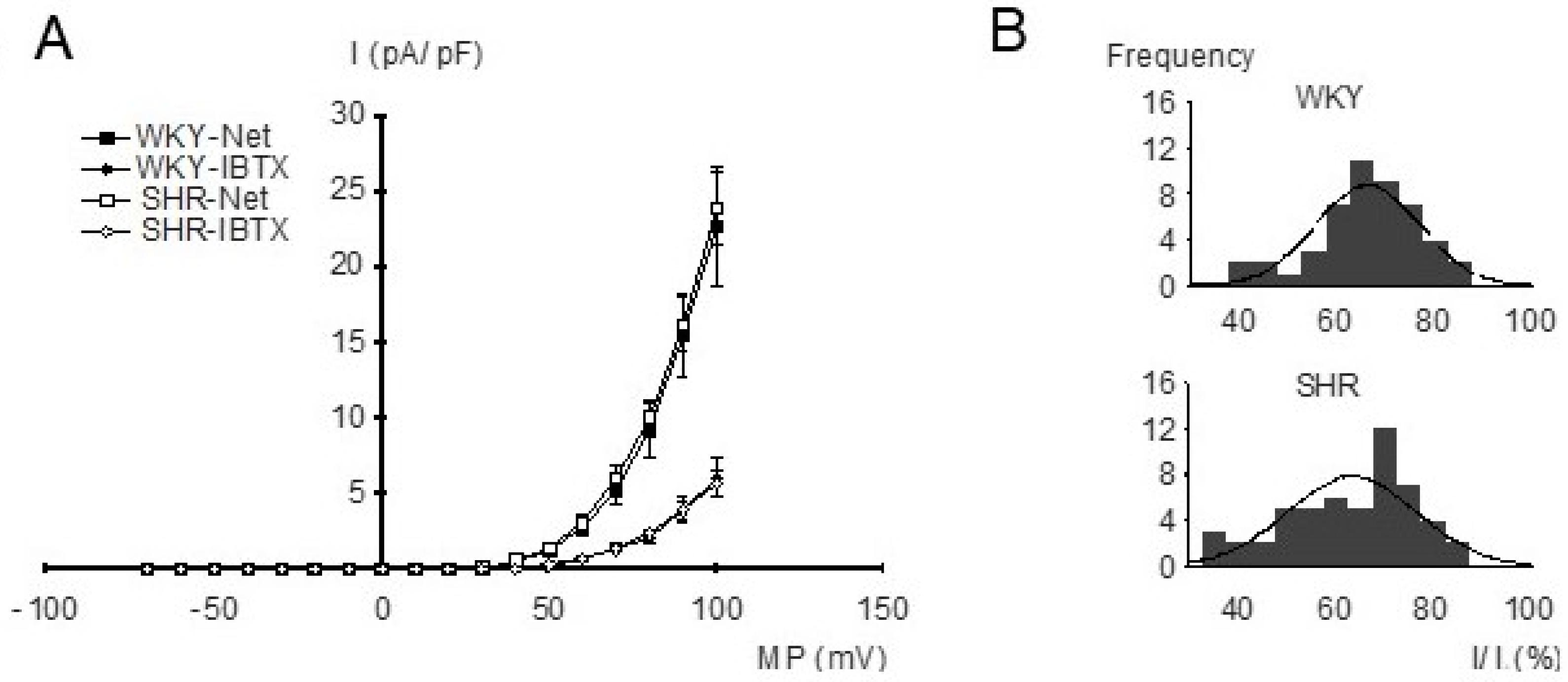

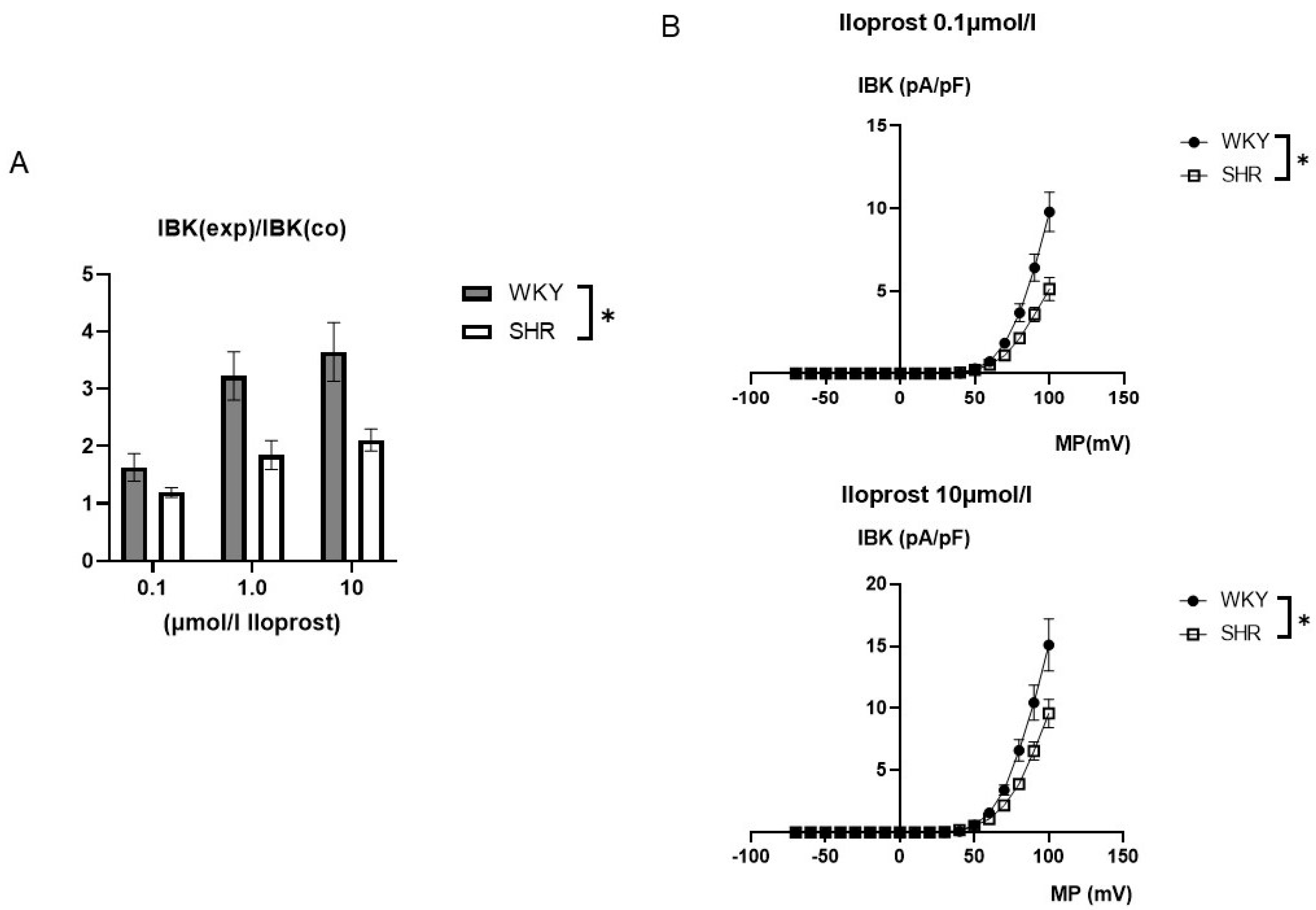

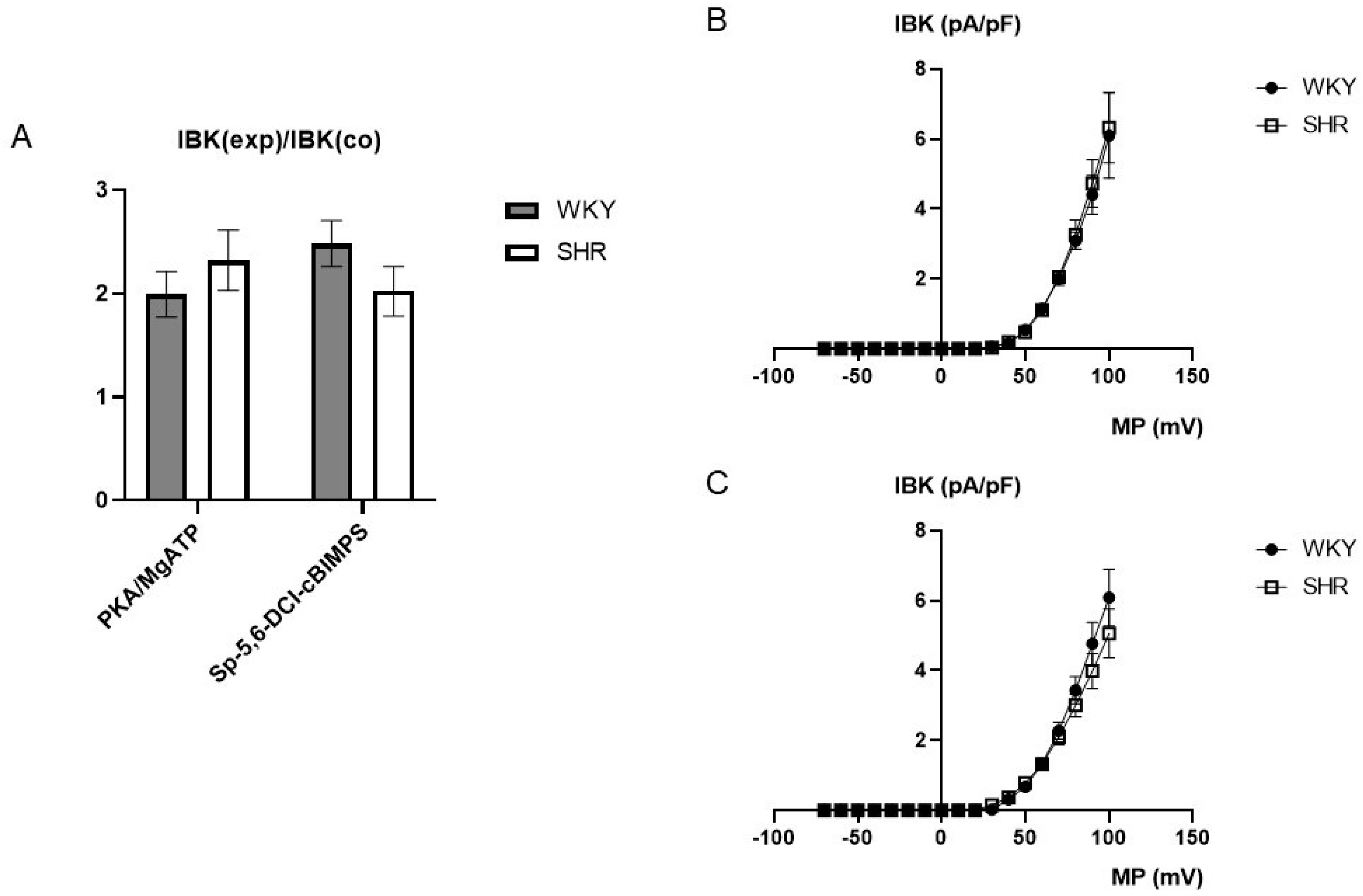
| WKY | SHR | n | p-Value | |
|---|---|---|---|---|
| pCa 5.9 | 11.6 ± 2.7 | 15.8 ± 4.9 | 7 | 0.48 |
| pCa 5.5 | 4.6 ± 1.9 | 4.3 ± 1.2 | 4 | 0.89 |
| pCa 4.9 | 1.5 ± 0.2 | 1.4 ± 0.3 | 5 | 0.95 |
Disclaimer/Publisher’s Note: The statements, opinions and data contained in all publications are solely those of the individual author(s) and contributor(s) and not of MDPI and/or the editor(s). MDPI and/or the editor(s) disclaim responsibility for any injury to people or property resulting from any ideas, methods, instructions or products referred to in the content. |
© 2024 by the authors. Licensee MDPI, Basel, Switzerland. This article is an open access article distributed under the terms and conditions of the Creative Commons Attribution (CC BY) license (https://creativecommons.org/licenses/by/4.0/).
Share and Cite
Pyanova, A.; Serebryakov, V.N.; Gagov, H.; Mladenov, M.; Schubert, R. BK Channels in Tail Artery Vascular Smooth Muscle Cells of Normotensive (WKY) and Hypertensive (SHR) Rats Possess Similar Calcium Sensitivity But Different Responses to the Vasodilator Iloprost. Int. J. Mol. Sci. 2024, 25, 7140. https://doi.org/10.3390/ijms25137140
Pyanova A, Serebryakov VN, Gagov H, Mladenov M, Schubert R. BK Channels in Tail Artery Vascular Smooth Muscle Cells of Normotensive (WKY) and Hypertensive (SHR) Rats Possess Similar Calcium Sensitivity But Different Responses to the Vasodilator Iloprost. International Journal of Molecular Sciences. 2024; 25(13):7140. https://doi.org/10.3390/ijms25137140
Chicago/Turabian StylePyanova, Anastasia, Vladimir N. Serebryakov, Hristo Gagov, Mitko Mladenov, and Rudolf Schubert. 2024. "BK Channels in Tail Artery Vascular Smooth Muscle Cells of Normotensive (WKY) and Hypertensive (SHR) Rats Possess Similar Calcium Sensitivity But Different Responses to the Vasodilator Iloprost" International Journal of Molecular Sciences 25, no. 13: 7140. https://doi.org/10.3390/ijms25137140





